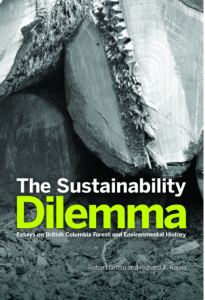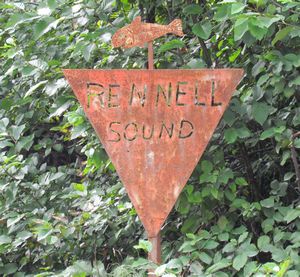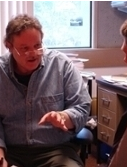#69 BC forestry politics and policy
The Sustainability Dilemma: Essays on British Columbia Forest and Environmental History
by Robert Griffin and Richard A. Rajala
Victoria: Royal British Columbia Museum Press, 2016
$34.95 / 9780772669742
Reviewed by Graeme Wynn
First published Dec. 28, 2016
*
In The Sustainability Dilemma, Robert Griffin and Richard Rajala explore contested issues, policies, and campaigns concerning the management of B.C. forests and the forest industry’s impact on freshwater ecosystems. Reviewer Graeme Wynn responds with the analytical lenses of forest history and environmental history — Ed.
*
 Should we judge this book by its cover, take its title at face value, or evaluate its content regardless of the packaging in which it is sold? This is the dilemma — the “difficult situation or problem” — confronting readers of The Sustainability Dilemma: Essays on British Columbia Forest and Environmental History.
Should we judge this book by its cover, take its title at face value, or evaluate its content regardless of the packaging in which it is sold? This is the dilemma — the “difficult situation or problem” — confronting readers of The Sustainability Dilemma: Essays on British Columbia Forest and Environmental History.
Think of words as balloons into which people blow their own and various meanings. Just as well-inflated balloons can be sent soaring, dipping, and diving on the most unpredictable of paths by the escape of air from their necks, so some words, blown into importance and released on the world, seem to carve particularly indecipherable trajectories through space and time.
“Sustainability” is surely a prime example. We have all seen and heard the term. But how do we grasp it, what does it mean? There are characterizations aplenty. The word is often associated with the notion of “sustainable development” — but this is of little help to those who wonder whether that coupling is oxymoronic.
Several efforts to explain sustainability seem to coalesce (in one form or another) around the idea that it marks the attainment of high levels of human comfort without degradation of natural eco-systems. Others see sustainability as an achievement contingent on the acceptance of environmental limits to economic progress and social advancement.
But each of these formulations leaves much unspecified. Without further clarification we are in something akin to Lewis Carroll’s looking glass world: “`When I use a word,’ Humpty Dumpty said, in rather a scornful tone, ‘it means just what I choose it to mean — neither more nor less.’ ‘The question is,’ said Alice, ‘whether you can make words mean so many different things.’ ‘The question is,’ said Humpty Dumpty, ‘which is to be master – that’s all.’”
“Forest history” and “environmental history” pose similar, if less-commonly encountered, dilemmas. Entire books have been devoted to discussions of approaches and methods in these scholarly fields, only to reveal that they are very broad tents indeed.
Mauro Agnoletti, a leading student of forest history in Europe, sees the subject “embracing the whole field of social and natural sciences, encompassing humans and nature as total phenomenon.”[1] This is to say — to provide only a very partial list — that it encompasses the development of forest policy, changing forestry practices, technological evolution, the shifting forms of work in the woods, and the life-history of trees, and forests and their broad ecological relations — which is also to say that it straddles, among other disciplines, anthropology, botany, ecology, economic-, social-, labour-, and legal- history, sociology, forestry, geography, genetics, and sociology.
Environmental history is equally catholic in scope. John McNeill, one of the field’s leading North American practitioners says, succinctly and confidently, that environmental history considers the “mutual relations between humankind and the rest of nature.”
Various efforts to distil its compass identify several main emphases. McNeill recognizes three main varieties of the subject: material environmental history that pays particular attention to the economic and technological dimensions of human affairs and to the ways in which they shape biophysical environments; cultural/ intellectual environmental history which explores representations of nature and their significance; and a political emphasis (the most traditional form of the field) that focuses upon the making of laws and policies and their effects upon the natural world.[2]In the broadest of terms, then, it can be said that forest and environmental history share an interest in the relations between people and environments, and in the reciprocal agency of humans and nature in shaping places or landscapes.
Perhaps swayed by advice of the sort once said to have been given a young historian by a much more seasoned colleague — “never discuss methodology in front of the students” — the authors of The Sustainability Dilemma largely eschew analysis and definition of the principles, approaches, and concepts featured on the cover of their book.
Instead, Griffin and Rajala plunge into a vast assortment of departmental files, parliamentary debates, official records, and contemporary commentaries pertaining to the forests of British Columbia. Beginning with Royal Commissioner Gordon Sloan’s support for forest management on “Sustained Yield” principles in his Royal Commission report of 1945, and proceeding through the expansion of pulp-milling operations in the 1960s, to consider controversies over extensive clear-cutting in the 1970s and 1980s, they offer an account centred on the political debates over, and policy choices pertaining to, provincial forests during these years.
In broad outline, this is a familiar story, rooted in political economy but with evident “political-environmental” dimensions. Jeremy Wilson, Gordon Hak, Patricia Marchak, Roger Hayter, and others, have provided (inevitably incomplete) interpretations of it in the last 30 years or so.
But Griffin and Rajala have both given years to the study of B.C.’s forests. Each has completed a doctoral dissertation on the subject. Griffin served as history curator at the Royal BC Museum (with special interest in the mining and forests industries) for more than thirty years, and Rajala, an Associate Professor in the history department of the University of Victoria, has devoted his scholarly career to understanding British Columbia. Both have published a good deal on B.C.’s forests, both know the archives intimately, and here they join together to focus on “historical events… [that] have been largely forgotten by the public and largely unexamined by scholars” (xv).
Co-authorships can take many forms, but The Sustainability Dilemma is a book in two parts, each reflecting the particular interests of its authors. Griffin wrote the three chapters that make up the first third of the book. The first of these traces B.C. forest policy through the labyrinth of regulations produced by efforts to implement the guiding principle of sustained yield while meeting industry’s diverse needs, responding to shifting government directives, reflecting different regional conditions, and doing so with inadequate information.

Griffin’s second chapter limns industry’s response to the government’s sustained yield policies by tracing the efforts of the Western Plywood (later Weldwood, then West Fraser) Company to establish a dominant position in B.C.’s central interior, and his third centres on Forest Minister Ray Williston’s introduction of Pulp Harvesting Areas to promote economic development through the construction of pulp mills. Here Griffin again focuses, by way of illustration, on the Weldwood company’s efforts to build a mill in Quesnel.
Rajala follows, filling out the remainder of the book with a pair of case studies focused on the impact of the forest industry on freshwater ecosystems. Dealing with the controversial Stellako River log drives in the central interior in the 1960s and the Riley Creek/ Rennell Sound landslides on Haida Gwaii in the following decade, these are long (over 100 pages each) and detailed exegeses.

The Stellako chapter adds illustrations to an essay that first appeared in BC Studies. This is a convoluted story that leads to the conclusion that “as a symbol, the Stellako was a river that led, in its meandering way, from a traditional B.C. of unbridled resource-based materialism to the one we inhabit today” (237). The outcome of the prolonged struggle over Riley Creek was ambiguous, but Rajala observes wryly that those who most clearly believed that they had won the battle (the defenders of clear-cutting) ultimately lost the war over land-use in Haida Gwaii, and they did so, in part, because their defence of such clear-cut ecological abuse fuelled public support for preservation.
Griffin has the lighter touch. His 30- to 50-page chapters move the story along and, in my view at least, his discussion of the Western Plywood/ Weldwood ventures is a valuable contribution to understanding the development of the forest industry in B.C. in the third quarter of the twentieth century.

Rajala has a heavier hand. He is an assiduous researcher whose generous spirit is manifest in his inclination to share almost everything revealed by his archival labours. But historians and others should sometimes heed the “Less is More” mantra of minimalist architect Mies van der Rohe: less complicated narratives are often better understood and more widely appreciated than their more prolix and complex counterparts. The Stellako and Riley Creek controversies were important, and there is much to be learned from Rajala’s accounts of them, but only the most dedicated of readers is likely to persist through these pages.

In the main, The Sustainability Dilemma is a book about the efforts of the B.C. Forest Service to manage the province’s forests before “sustainability” began to trip lightly off the tongues of foresters, academics, and the public at large. These were years in which politicians, civil servants, scientists, captains of industry, labour leaders, and an emerging environmental movement wrestled one other to advance particular agendas for the forests — agendas that turned, variously, on royalties, profits, jobs, aesthetics, and ecology.
There is much here on sustained yield policies, and Rajala’s chapters throw a deal of new light on the vexed political (and environmental) issues surrounding what are now called “fish-forest interactions.” But although Rajala suggests that the story of Riley Creek can be read, hopefully, as an indication “that science and technology can indeed be marshalled in ways that allow us to achieve a sustainable relationship with ‘non-human nature,’” he admits that the self-same story can be used to provide “a measure of legitimacy to the politicians and administrators whose actions sacrificed a stream’s health to federal-provincial gamesmanship,” and ultimately concedes that B.C.s approach to balancing interests by zoning areas for intensive forestry and preservation “avoids the harder question of how to go about meeting the full range of human needs in a truly sustainable way” (330).
Without full explanation of the differences between Sustained Yield management (intended to ensure the continuing viability of forest industries, and focused on the benefits not the costs of exploitation) and sustainability (the goal of human-ecosystem equilibrium), and less engaged than it might have been with a question that has engaged many historians — why history matters and how it can help us make sense of the world today — this book is of limited value in dealing with current, and urgent, environmental challenges or in finding a path toward the elusive goal of sustainability.
Instead, read The Sustainability Dilemma for a deft interpretation of the reasons for, and the challenges posed by, the rise of the pulp and paper industry, and for its “definitive” accounts of the Stellako and Riley Creek controversies. Admire, and ponder, its many illustrations. But always remember that history is at its best, most powerful, and most useful when it fires the imagination rather than when it rests content with recounting facts.[3] And don’t forget what your mother told you: “never judge a book by its cover.”
*

Trained as an historical geographer, Graeme Wynn has had a career-long fascination with and involvement in environmental history. Rooted in these two disciplines and engaged with the environmental sciences, his research is interdisciplinary, and its foci have broadened over time from eastern Canada to New Zealand, the rest of Canada and (to lesser degree) Australia and South Africa. A fair part of this work has focused on forest exploitation, conservation, preservation, and management; among his most recent publications is a review essay: “Forest$ustainability:” in BC Studies, 190, 115-31. Recently retired after forty plus years at UBC, Wynn served that institution as Associate Dean of Arts and Head of the Department of Geography. He is General Editor of the Nature|History|Society monograph series with UBC Press which now includes almost thirty volumes. He was editor of BC Studies between 2008 and 2016. In 2017 he will become President of the American Society for Environmental History for a two-year term.
*
Endnotes:
[1] Mauro Agnoletti, “Introduction: the Development of Forest History Research,” in M. Agnoletti and Steven Anderson (eds.), Methods and Approaches in Forest History (Wallingford, UK; New York, USA: CABI Publishers. in association with the International Union of Forestry Research Organizations, 2000), 6
[2] John R. McNeill, “Observations on the Nature and Culture of Environmental History,” History and Theory, 42 (December 2003), 5-43
[3] On this point, see Stephen Fry, “The Future’s in the Past,” The Observer, Sunday 9 July 2006.
*
The Ormsby Review. More Readers. More Reviews. More Often.
Reviews Editor: Richard Mackie
Reviews Publisher: Alan Twigg
The Ormsby Review is hosted by Simon Fraser University.
—
BC BookWorld
ABCBookWorld
BCBookLook
BC BookAwards
The Literary Map of B.C.
The Ormsby Review
Comments are closed.